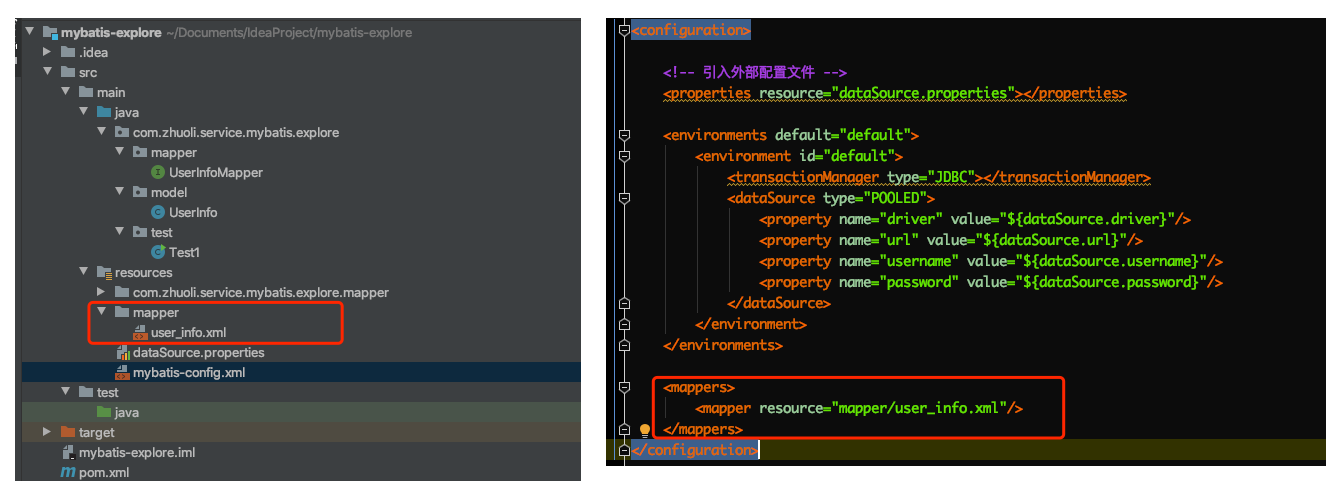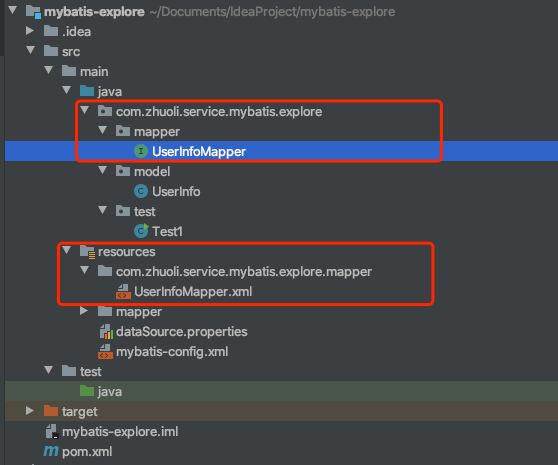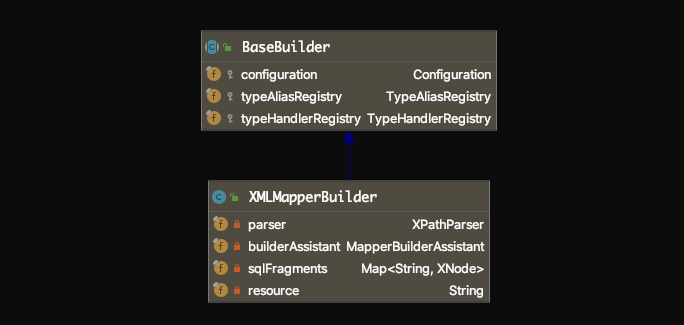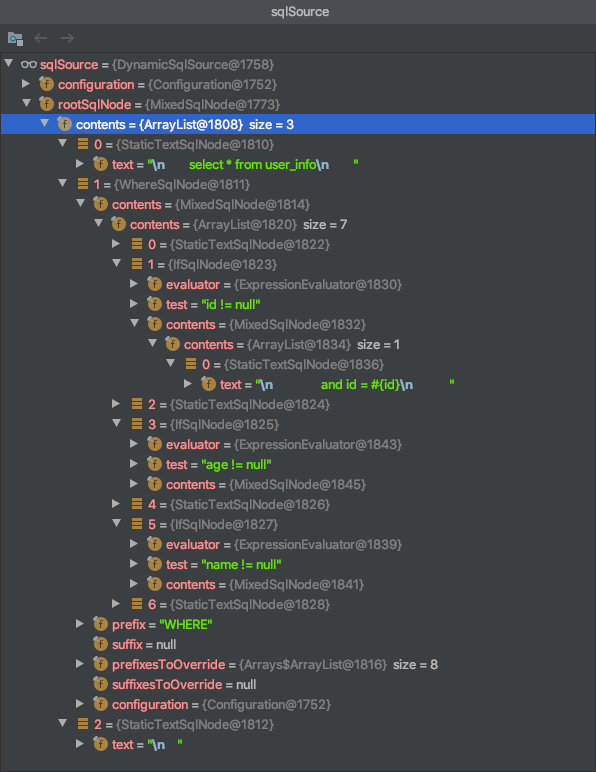上篇文章我们介绍了Mybatis如何将配置文件解析为Configuration对象,Mybatis中还有一个重要的SQL映射文件(mapper映射文件),用于配置sql相关信息,也需要被解析。在Mybatis配置文件中,通过”<mappers>”标签将SQL映射文件引入。
<!-- mapper文件映射配置 -->
<mappers>
<package name="com.zhuoli.service.mybatis.explore.mapper"/>
</mappers><!-- mapper文件映射配置 -->
<mappers>
<mapper resource="mapper/user_info.xml"/>
</mappers><!-- mapper文件映射配置 -->
<mappers>
<mapper url="file:///Users/chenhao/Documents/IdeaProject/mybatis-explore/src/main/resources/mapper/user_info.xml"/>
</mappers><!-- mapper文件映射配置 -->
<mappers>
<mapper class="com.zhuoli.service.mybatis.explore.mapper.UserInfoMapper"/>
</mappers>上篇文章我们也大致介绍了”<mappers>”标签解析的入口。
private void mapperElement(XNode parent) throws Exception {
if (parent != null) {
// 遍历<mappers>节点下的子节点
for (XNode child : parent.getChildren()) {
// 如果子节点为<package>
if ("package".equals(child.getName())) {
String mapperPackage = child.getStringAttribute("name");
configuration.addMappers(mapperPackage);
} else {
// 否则子节点为<mapper>,则获取子节点<mapper>的"resource"、"url"、"class"属性,三个属性只能定义其中的一个
String resource = child.getStringAttribute("resource");
String url = child.getStringAttribute("url");
String mapperClass = child.getStringAttribute("class");
if (resource != null && url == null && mapperClass == null) {
// "resource"不为空
ErrorContext.instance().resource(resource);
InputStream inputStream = Resources.getResourceAsStream(resource);
XMLMapperBuilder mapperParser = new XMLMapperBuilder(inputStream, configuration, resource, configuration.getSqlFragments());
mapperParser.parse();
} else if (resource == null && url != null && mapperClass == null) {
// "url"属性不为空
ErrorContext.instance().resource(url);
InputStream inputStream = Resources.getUrlAsStream(url);
XMLMapperBuilder mapperParser = new XMLMapperBuilder(inputStream, configuration, url, configuration.getSqlFragments());
mapperParser.parse();
} else if (resource == null && url == null && mapperClass != null) {
// "class"属性不为空
Class<?> mapperInterface = Resources.classForName(mapperClass);
configuration.addMapper(mapperInterface);
} else {
throw new BuilderException("A mapper element may only specify a url, resource or class, but not more than one.");
}
}
}
}
}本篇文章我们就来详细介绍”<mappers>”标签解析的细节实现。”<mappers>”有四种配置方式,无论使用哪种配置方式,其实SQL映射文件解析最终是通过XMLMapperBuilder完成的,这点我们接下来会介绍原因。
1. package配置
<!-- mapper文件映射配置 -->
<mappers>
<package name="com.zhuoli.service.mybatis.explore.mapper"/>
</mappers>这种方式,看似好像我们只配置了Mapper类所在的包,那么这些Mapper类对应的xml配置文件是如何解析的?
if ("package".equals(child.getName())) {
String mapperPackage = child.getStringAttribute("name");
configuration.addMappers(mapperPackage);
}可以看出,是通过调用Configuration类的addMappers方法实现的。
public void addMappers(String packageName) {
mapperRegistry.addMappers(packageName);
}在Configuration类的addMappers方法中,调用了MapperRegistry类的addMappers方法。
**
* Adds the mappers.
*
* @param packageName
* the package name
* @since 3.2.2
*/
public void addMappers(String packageName) {
addMappers(packageName, Object.class);
}public void addMappers(String packageName, Class<?> superType) {
ResolverUtil<Class<?>> resolverUtil = new ResolverUtil<>();
// 1. 查找包下所有父类为superType(Object.class)的类(Mapper接口)
resolverUtil.find(new ResolverUtil.IsA(superType), packageName);
Set<Class<? extends Class<?>>> mapperSet = resolverUtil.getClasses();
// 2. 遍历从包中扫描到的类(Mapper接口),调用addMapper方法解析
for (Class<?> mapperClass : mapperSet) {
addMapper(mapperClass);
}
}public <T> void addMapper(Class<T> type) {
if (type.isInterface()) {
if (hasMapper(type)) {
throw new BindingException("Type " + type + " is already known to the MapperRegistry.");
}
boolean loadCompleted = false;
try {
// 1. 将Mapper接口,添加到knownMappers,value为MapperProxyFactory,用于生成接口的代理对象
knownMappers.put(type, new MapperProxyFactory<>(type));
// 2. 初始化MapperAnnotationBuilder,解析Mapper接口
MapperAnnotationBuilder parser = new MapperAnnotationBuilder(config, type);
parser.parse();
loadCompleted = true;
} finally {
if (!loadCompleted) {
knownMappers.remove(type);
}
}
}
}MapperRegistry的knownMappers,用于存储接口类型到该接口代理工厂的映射,至于该代理工厂的作用,我们后面介绍sql执行时再详细介绍。
然后就是初始化了一个MapperAnnotationBuilder,并调用parse方法,解析Mapper接口。
public void parse() {
String resource = type.toString();
// 如果resource(Mapper接口类toString)还没被加载
// resource = "interface com.zhuoli.service.mybatis.explore.mapper.UserInfoMapper"
if (!configuration.isResourceLoaded(resource)) {
// 1. 加载并解析xml SQL映射文件
loadXmlResource();
// 2. 将resource添加到loadedResources中
configuration.addLoadedResource(resource);
// 3. MapperBuilderAssistant将currentNamespace设置为接口类名
assistant.setCurrentNamespace(type.getName());
// 4. 解析Mapper接口类@CacheNamespace
parseCache();
// 5. 解析Mapper接口类@CacheNamespaceRef
parseCacheRef();
// 6. 遍历Mapper接口类中所有方法,解析直接配置在接口方法上的注解,比如@select
for (Method method : type.getMethods()) {
if (!canHaveStatement(method)) {
continue;
}
if (getAnnotationWrapper(method, false, Select.class, SelectProvider.class).isPresent()
&& method.getAnnotation(ResultMap.class) == null) {
parseResultMap(method);
}
try {
parseStatement(method);
} catch (IncompleteElementException e) {
configuration.addIncompleteMethod(new MethodResolver(this, method));
}
}
}
parsePendingMethods();
}接下来,继续来看一下,loadXmlResource方法。
private void loadXmlResource() {
// Spring may not know the real resource name so we check a flag
// to prevent loading again a resource twice
// this flag is set at XMLMapperBuilder#bindMapperForNamespace
if (!configuration.isResourceLoaded("namespace:" + type.getName())) {
String xmlResource = type.getName().replace('.', '/') + ".xml";
// #1347
InputStream inputStream = type.getResourceAsStream("/" + xmlResource);
if (inputStream == null) {
// Search XML mapper that is not in the module but in the classpath.
try {
inputStream = Resources.getResourceAsStream(type.getClassLoader(), xmlResource);
} catch (IOException e2) {
// ignore, resource is not required
}
}
if (inputStream != null) {
XMLMapperBuilder xmlParser = new XMLMapperBuilder(inputStream, assistant.getConfiguration(), xmlResource, configuration.getSqlFragments(), type.getName());
xmlParser.parse();
}
}
}可以看到,最终使用了XMLMapperBuilder来解析SQL映射文件对应的文件流。还有一个细节需要注意,这里获取SQL映射文件流的方式是:
String xmlResource = type.getName().replace('.', '/') + ".xml";
InputStream inputStream = type.getResourceAsStream("/" + xmlResource);使用的是Class.getResourceAsStream(String path),并且path以”/”打头,所以默认获取的是classpath下对应文件夹下的xml映射文件,举个例子,我们的Mapper接口全路径为”com.zhuoli.service.mybatis.explore.mapper.UserInfoMapper”,则必须保证classpath下SQL映射文件路径为”/com/zhuoli/service/mybatis/explore/mapper/UserInfoMapper.xml”,否则无法读取到SQL映射文件。
由于其它几种mapper映射文件配置最终也会使用到XMLMapperBuilder,所以XMLMapperBuilder如何解析配置文件的,我们留在后面介绍。
2. resource配置
<!-- mapper文件映射配置 -->
<mappers>
<mapper resource="mapper/user_info.xml"/>
</mappers>resource配置的方式,我们配置了SQL映射文件的路径,注意这里是相对classpath的相对路径。
if (resource != null && url == null && mapperClass == null) {
ErrorContext.instance().resource(resource);
InputStream inputStream = Resources.getResourceAsStream(resource);
XMLMapperBuilder mapperParser = new XMLMapperBuilder(inputStream, configuration, resource, configuration.getSqlFragments());
mapperParser.parse();
}可以看到,也是先获取SQL映射文件的InputStream,然后调用XMLMapperBuilder的parse方法解析SQL映射文件的。
关于获取文件流,我们来看一下为什么配置文件中配置的是相对路径。跟进一下Resources类的getResourceAsStream方法:
# Resources
public static InputStream getResourceAsStream(String resource) throws IOException {
return getResourceAsStream(null, resource);
}
public static InputStream getResourceAsStream(ClassLoader loader, String resource) throws IOException {
InputStream in = classLoaderWrapper.getResourceAsStream(resource, loader);
if (in == null) {
throw new IOException("Could not find resource " + resource);
}
return in;
}可以看到,最终是通过ClassLoader.getResourceAsStream完成文件流获取的,所以,SQL映射文件必须配置在classpath下,并且路径配置不能以”/”打头。

3. url配置
<!-- mapper文件映射配置 -->
<mappers>
<mapper url="file:///Users/chenhao/Documents/IdeaProject/mybatis-explore/src/main/resources/mapper/user_info.xml"/>
</mappers>url配置方式,我们可以配置一些文件系统的绝对路径,也可以配置网络环境的映射文件地址。
if (resource == null && url != null && mapperClass == null) {
ErrorContext.instance().resource(url);
InputStream inputStream = Resources.getUrlAsStream(url);
XMLMapperBuilder mapperParser = new XMLMapperBuilder(inputStream, configuration, url, configuration.getSqlFragments());
mapperParser.parse();
}可以看到,解析步骤跟上述resource配置方式一致,也是先获取SQL映射文件流,然后调用XMLMapperBuilder的parse方法解析SQL映射文件。这里url配置支持本地文件绝对路径方式,也支持网络url远端配置。
4. class配置
<!-- mapper文件映射配置 -->
<mappers>
<mapper class="com.zhuoli.service.mybatis.explore.mapper.UserInfoMapper"/>
</mappers>class配置方式,我们配置了映射文件类的类名。
if (resource == null && url == null && mapperClass != null) {
Class<?> mapperInterface = Resources.classForName(mapperClass);
configuration.addMapper(mapperInterface);
}可以看到,class配置方式,先获取了配置的Mapper接口Class,然后调用configuration的addMapper方法解析。之前介绍package配置的时候,已经介绍过,addMapper方法中也会获取文件流,然后调用XMLMapperBuilder类的parse方法解析SQL映射文件,后续流程其实跟package方式是相同的。
5. XMLMapperBuilder
上面介绍到,无论通过什么方式配置SQL映射文件,最终解析SQL映射文件内容的都是通过XMLMapperBuilder完成的。接下来我们就来详细看一下XMLMapperBuilder是如何解析SQL映射文件的。
public XMLMapperBuilder(InputStream inputStream, Configuration configuration, String resource, Map<String, XNode> sqlFragments) {
this(new XPathParser(inputStream, true, configuration.getVariables(), new XMLMapperEntityResolver()),
configuration, resource, sqlFragments);
}
private XMLMapperBuilder(XPathParser parser, Configuration configuration, String resource, Map<String, XNode> sqlFragments) {
super(configuration);
this.builderAssistant = new MapperBuilderAssistant(configuration, resource);
this.parser = parser;
this.sqlFragments = sqlFragments;
this.resource = resource;
}
public XPathParser(InputStream inputStream, boolean validation, Properties variables, EntityResolver entityResolver) {
commonConstructor(validation, variables, entityResolver);
this.document = createDocument(new InputSource(inputStream));
}首先是构造函数,XMLMapperBuilder类继承关系如下:
之前的文章介绍Mybatis配置文件解析的时候,介绍过一个XMLConfigBuilder,同样继承于BaseBuilder。BaseBuilder中存在两个三个成员变量:
- configuration:Mybatis配置文件解析后生成的对应对象(之前通过XMLConfigBuilder解析生成的)
- typeAliasRegistry:别名配置,configuration的成员变量,解析Mybatis配置文件过程中生成
- typeHandlerRegistry:类型处理器,用于JDBC类型和java类型的转换,解析Mybatis配置文件过程中生成
XMLMapperBuilder中存在如下几个重要的成员变量:
- parser:用于从SQL映射文件流中获取处理某个节点,即XML DOM解析
- builderAssistant:SQL映射文件处理器,用于辅助解析一些SQL映射文件中的节点,如”cache”节点
- sqlFragments:SQL映射文件中”sql”节点,id -> XNode存储
- resource:SQL映射文件路径,XMLConfigBuilder中只适用于判断SQL映射文件是否已经被解析,因为SQL映射文件流已经在构造函数中传入了
接下来我们来看一下XMLMapperBuilder解析SQL映射文件的入口,也就是parse方法。
public void parse() {
// 如果SQL映射文件还未被解析过,则解析SQL映射文件
if (!configuration.isResourceLoaded(resource)) {
// 1. 解析"mapper"节点
configurationElement(parser.evalNode("/mapper"));
// 2. 将资源SQL映射文件添加到"已解析资源"集合中
configuration.addLoadedResource(resource);
// 3. 为nameSpace绑定Mapper接口
bindMapperForNamespace();
}
parsePendingResultMaps();
parsePendingCacheRefs();
parsePendingStatements();
}该解析方法的核心就在上述步骤1、3,接下来我们来看一下细节实现。
5.1 mapper节点解析
一份完整的SQL映射文件配置如下:
<?xml version="1.0" encoding="UTF-8"?>
<!DOCTYPE mapper PUBLIC "-//mybatis.org//DTD Mapper 3.0//EN" "http://mybatis.org/dtd/mybatis-3-mapper.dtd">
<mapper namespace="com.zhuoli.service.mybatis.explore.mapper.UserInfoMapper">
<resultMap id="userInfoResult" type="com.zhuoli.service.mybatis.explore.model.UserInfo">
<result property="id" column="id" jdbcType="BIGINT"/>
<result property="name" column="name" jdbcType="VARCHAR"/>
<result property="age" column="age" jdbcType="INTEGER"/>
</resultMap>
<cache/>
<sql id="table">user_info</sql>
<select id="queryAllUser" resultMap="userInfoResult">
select * from <include refid="table"/>;
</select>
<select id="queryUserInfoById" resultMap="userInfoResult" parameterType="java.lang.Long">
select * from user_info where id = #{id};
</select>
<insert id="addUser" parameterType="com.zhuoli.service.mybatis.explore.model.UserInfo" useGeneratedKeys="true" keyProperty="id">
insert into user_info (name, age) values (#{name}, #{age})
</insert>
<delete id="delUserById" parameterType="java.lang.Long">
delete from user_info where id = #{id};
</delete>
<update id="updateUserAge">
update user_info set age = #{age} where id = #{id}
</update>
</mapper>在SQL配置文件中,根节点是<mapper>,在根节点<mapper>下,我们可以配置多种节点,比如 <cache>、<resultMap>、<sql> 、 <select>、<insert>、<delete>、<update> 等。而SQL映射文件中<mapper>节点解析,就是该节点下配置的各子节点的解析过程,解析方法是configurationElement方法。
private void configurationElement(XNode context) {
try {
// 获取mapper节点的"namespace"属性,比如"com.zhuoli.service.mybatis.explore.mapper.UserInfoMapper"
String namespace = context.getStringAttribute("namespace");
if (namespace == null || namespace.isEmpty()) {
throw new BuilderException("Mapper's namespace cannot be empty");
}
// 将命名空间设置到到builderAssistant的currentNamespace成员中
builderAssistant.setCurrentNamespace(namespace);
// 解析<cache-ref>节点
cacheRefElement(context.evalNode("cache-ref"));
// 解析<cache>节点
cacheElement(context.evalNode("cache"));
// 解析<parameterMap>节点,老式风格的参数映射,此元素已被废弃
parameterMapElement(context.evalNodes("/mapper/parameterMap"));
// 解析<resultMap>节点
resultMapElements(context.evalNodes("/mapper/resultMap"));
// 解析<sql>节点
sqlElement(context.evalNodes("/mapper/sql"));
// 解析 <select>、<insert>、<update>、<delete> 节点
buildStatementFromContext(context.evalNodes("select|insert|update|delete"));
} catch (Exception e) {
throw new BuilderException("Error parsing Mapper XML. The XML location is '" + resource + "'. Cause: " + e, e);
}
}5.1.1 cache节点解析——cacheElement
MyBatis提供了一、二级缓存,其中一级缓存是SqlSession级别的,默认开启。二级缓存配置在映射文件中,使用者需要显示配置才能开启(也就是在SQL映射文件中通过<cache>节点配置)。如下:
<cache/>我们也可以对二级缓存做一些配置,如下:
<cache eviction="LRU" flushInterval="60000" size="512" readOnly="true"/>- eviction:缓存淘汰策略,这里使用LRU算法,即当缓存需要淘汰时,优先淘汰最久未使用的对象
- flushInterval:缓存刷新时间,这里配置每60秒刷新一次
- size:缓存的容量,这里配置512个对象引用
- readOnly:只读缓存,默认为false,这里设置为true,表明用户从缓存中获取对象后,不要再修改对象进行修改,否则会影响其他用户的查询
cacheElement方法用于解析<cache>节点,其实Mybatis二级缓存在使用上存在一些问题,所以线上使用较少,即使使用也是一些特定的场景。
private void cacheElement(XNode context) {
if (context != null) {
// 获取type属性,如果未指定type,默认为PERPETUAL(typeAliases中注册,类型为PerpetualCache)
String type = context.getStringAttribute("type", "PERPETUAL");
// 通过缓存类型名,解析该别名对应的Class
Class<? extends Cache> typeClass = typeAliasRegistry.resolveAlias(type);
// 获取缓存淘汰方式,如果未指定,默认为"LRU"
String eviction = context.getStringAttribute("eviction", "LRU");
// 获取缓存淘汰方式别名,解析该别名对应的Class
Class<? extends Cache> evictionClass = typeAliasRegistry.resolveAlias(eviction);
// 获取缓存刷新时间
Long flushInterval = context.getLongAttribute("flushInterval");
// 获取缓存容量大小
Integer size = context.getIntAttribute("size");
// 获取缓存readOnly属性
boolean readWrite = !context.getBooleanAttribute("readOnly", false);
boolean blocking = context.getBooleanAttribute("blocking", false);
// 获取<cache>节点下的<property>子节点name-value对,生成properties
Properties props = context.getChildrenAsProperties();
// 构建缓存对象
builderAssistant.useNewCache(typeClass, evictionClass, flushInterval, size, readWrite, blocking, props);
}大致可以分为两部分,首先是获取<cache>属性配置,其次是调用builderAssistant的userNewCache方法,生成Cache对象。接下来我们来看一下如何构建Cache对象的。
public Cache useNewCache(Class<? extends Cache> typeClass,
Class<? extends Cache> evictionClass,Long flushInterval,
Integer size,boolean readWrite,boolean blocking,Properties props) {
// 使用构造者模式构建缓存实例
Cache cache = new CacheBuilder(currentNamespace)
.implementation(valueOrDefault(typeClass, PerpetualCache.class))
.addDecorator(valueOrDefault(evictionClass, LruCache.class))
.clearInterval(flushInterval)
.size(size)
.readWrite(readWrite)
.blocking(blocking)
.properties(props)
.build();
// 添加缓存到Configuration对象中
configuration.addCache(cache);
// 设置currentCache属性,即当前使用的缓存
currentCache = cache;
return cache;
}这里Cache的生成,使用了构造者模式,即CacheBuilder。
public Cache build() {
// 设置默认的缓存类型(PerpetualCache)和缓存装饰器(LruCache)
setDefaultImplementations();
// 通过反射创建缓存
Cache cache = newBaseCacheInstance(implementation, id);
setCacheProperties(cache);
// 对PerpetualCache缓存应用装饰器
if (PerpetualCache.class.equals(cache.getClass())) {
// 遍历装饰器集合,应用装饰器
for (Class<? extends Cache> decorator : decorators) {
// 通过反射创建装饰器实例
cache = newCacheDecoratorInstance(decorator, cache);
// 设置属性值到缓存实例中
setCacheProperties(cache);
}
// 应用标准的装饰器,比如 LoggingCache、SynchronizedCache
cache = setStandardDecorators(cache);
} else if (!LoggingCache.class.isAssignableFrom(cache.getClass())) {
// 应用具有日志功能的缓存装饰器
cache = new LoggingCache(cache);
}
return cache;
}
private void setDefaultImplementations() {
if (this.implementation == null) {
//设置默认缓存类型为PerpetualCache
this.implementation = PerpetualCache.class;
if (this.decorators.isEmpty()) {
this.decorators.add(LruCache.class);
}
}
}
private Cache newBaseCacheInstance(Class<? extends Cache> cacheClass, String id) {
//获取构造器
Constructor cacheConstructor = this.getBaseCacheConstructor(cacheClass);
try {
//通过构造器实例化Cache
return (Cache)cacheConstructor.newInstance(id);
} catch (Exception var5) {
throw new CacheException("Could not instantiate cache implementation (" + cacheClass + "). Cause: " + var5, var5);
}
}如上就完成了<cache>节点的解析,解析结果就是创建了一个Cache的实例对象,然后添加到Configuration中,并且设置到BuilderAssistant的currentCache属性中,至于cache是如何生效的,后面的文章中再介绍。
5.1.2 resultMap节点解析——resultMapElements
resultMap主要用于结果映射,之前介绍的文章中,我们使用JDBC时,结果到对象的映射需要程序员自己遍历ResultSet,完成查询结果到对象的映射。而Mybatis支持通过自定义配置<resultMap>的方式,帮我们自动完成查询结果到对象的映射。resultMap节点配置如下:
<resultMap id="userInfoResult" type="com.zhuoli.service.mybatis.explore.model.UserInfo">
<result property="id" column="id" jdbcType="BIGINT"/>
<result property="name" column="name" jdbcType="VARCHAR"/>
<result property="age" column="age" jdbcType="INTEGER"/>
</resultMap>resultMap节点是通过resultMapElements方法解析的。
private void resultMapElements(List<XNode> list) {
// 遍历处理每一个<resultMap>节点
for (XNode resultMapNode : list) {
try {
resultMapElement(resultMapNode);
} catch (IncompleteElementException e) {
// ignore, it will be retried
}
}
}private ResultMap resultMapElement(XNode resultMapNode) {
return resultMapElement(resultMapNode, Collections.emptyList(), null);
}
private ResultMap resultMapElement(XNode resultMapNode, List<ResultMapping> additionalResultMappings, Class<?> enclosingType) {
ErrorContext.instance().activity("processing " + resultMapNode.getValueBasedIdentifier());
// 获取<resultMap>节点type属性
String type = resultMapNode.getStringAttribute("type",
resultMapNode.getStringAttribute("ofType",
resultMapNode.getStringAttribute("resultType",
resultMapNode.getStringAttribute("javaType"))));
// 获取type对应的Class
Class<?> typeClass = resolveClass(type);
if (typeClass == null) {
typeClass = inheritEnclosingType(resultMapNode, enclosingType);
}
Discriminator discriminator = null;
// 创建ResultMapping集合,该集合中存储当前<resultMap>节点的子节点
List<ResultMapping> resultMappings = new ArrayList<>(additionalResultMappings);
// 获取<resultMap>所有的子节点
List<XNode> resultChildren = resultMapNode.getChildren();
// 遍历<resultMap>所有的子节点
for (XNode resultChild : resultChildren) {
if ("constructor".equals(resultChild.getName())) {
processConstructorElement(resultChild, typeClass, resultMappings);
} else if ("discriminator".equals(resultChild.getName())) {
discriminator = processDiscriminatorElement(resultChild, typeClass, resultMappings);
} else {
// <id>节点&<result>节点处理
List<ResultFlag> flags = new ArrayList<>();
if ("id".equals(resultChild.getName())) {
flags.add(ResultFlag.ID);
}
// 将id或result节点生成相应的ResultMapping,并添加到resultMappings集合中
resultMappings.add(buildResultMappingFromContext(resultChild, typeClass, flags));
}
}
// 获取<resultMap>节点id属性
String id = resultMapNode.getStringAttribute("id",
resultMapNode.getValueBasedIdentifier());
// 获取<resultMap>节点extends属性
String extend = resultMapNode.getStringAttribute("extends");
// 获取<resultMap>节点autoMapping属性
Boolean autoMapping = resultMapNode.getBooleanAttribute("autoMapping");
// 创建ResultMapResolver对象
ResultMapResolver resultMapResolver = new ResultMapResolver(builderAssistant, id, typeClass, extend, discriminator, resultMappings, autoMapping);
try {
// 通过ResultMapResolver构建ResultMap对象
return resultMapResolver.resolve();
} catch (IncompleteElementException e) {
configuration.addIncompleteResultMap(resultMapResolver);
throw e;
}
}上述<resultMap>节点解析的核心是<resultMap>节点的子节点转换为ResultMapping对象的过程,也就是buildResultMappingFromContext方法,我们来跟进一下该方法。
private ResultMapping buildResultMappingFromContext(XNode context, Class<?> resultType, List<ResultFlag> flags) {
String property;
if (flags.contains(ResultFlag.CONSTRUCTOR)) {
property = context.getStringAttribute("name");
} else {
property = context.getStringAttribute("property");
}
String column = context.getStringAttribute("column");
String javaType = context.getStringAttribute("javaType");
String jdbcType = context.getStringAttribute("jdbcType");
// 获取嵌套select查询属性
String nestedSelect = context.getStringAttribute("select");
// 获取嵌套结果映射属性
String nestedResultMap = context.getStringAttribute("resultMap", () ->
processNestedResultMappings(context, Collections.emptyList(), resultType));
String notNullColumn = context.getStringAttribute("notNullColumn");
String columnPrefix = context.getStringAttribute("columnPrefix");
String typeHandler = context.getStringAttribute("typeHandler");
String resultSet = context.getStringAttribute("resultSet");
String foreignColumn = context.getStringAttribute("foreignColumn");
// 获取延迟查询属性,跟上述嵌套select相关,允许延迟查询,则嵌套查询结果不会立即返回
boolean lazy = "lazy".equals(context.getStringAttribute("fetchType", configuration.isLazyLoadingEnabled() ? "lazy" : "eager"));
// 获取javaType属性对应的Class
Class<?> javaTypeClass = resolveClass(javaType);
// 获取typeHandler对应的Class类型
Class<? extends TypeHandler<?>> typeHandlerClass = resolveClass(typeHandler);
// 获取jdbcType枚举
JdbcType jdbcTypeEnum = resolveJdbcType(jdbcType);
// 构建ResultMapping对象
return builderAssistant.buildResultMapping(resultType, property, column, javaTypeClass, jdbcTypeEnum, nestedSelect, nestedResultMap, notNullColumn, columnPrefix, typeHandlerClass, flags, resultSet, foreignColumn, lazy);
}关于子节点解析时,嵌套select查询和嵌套结果映射,这里再详细介绍一下。分别对应”select”属性和”resultMap”属性。这两个属性只出现在<association>和<collection>两个子节点中(association是一个类型的关联,collection是一个集合的关联,详细参考Mybatis官方文档)。如果包含”select”属性,则表明为嵌套select查询,如果包含”resultMap”属性,则表名为嵌套结果映射。关于嵌套select查询和嵌套结果映射,这里简单的介绍一下区别就是,嵌套select查询需要额外的sql查询,而嵌套结果映射不需要再做额外的sql查询(只是结果映射,一般用于处理sql join的结果映射)。
所以嵌套结果映射,需要获取嵌套映射对应的resultMap,也就是:
String nestedResultMap = context.getStringAttribute("resultMap", () ->
processNestedResultMappings(context, Collections.emptyList(), resultType));如果<association>和<collection>节点存在resultMap属性,则直接获取该属性返回;否则调用processNestedResultMappings方法尝试生成ResultMap对象,并返回生成resultMap的id。之所以需要processNestedResultMappings方法,是因为嵌套结果映射存在两种配置方式,如下:
<resultMap id="blogResult" type="Blog">
<id property="id" column="blog_id" />
<result property="title" column="blog_title"/>
<association property="author" column="blog_author_id" javaType="Author" resultMap="authorResult"/>
</resultMap>
<resultMap id="authorResult" type="Author">
<id property="id" column="author_id"/>
<result property="username" column="author_username"/>
<result property="password" column="author_password"/>
<result property="email" column="author_email"/>
<result property="bio" column="author_bio"/>
</resultMap>这种方式,authorResult对应的resultMap是可以复用的。但是也存在一些不需要复用的resultMap,我们可以使用第二种方式配置:
<resultMap id="blogResult" type="Blog">
<id property="id" column="blog_id" />
<result property="title" column="blog_title"/>
<association property="author" javaType="Author">
<id property="id" column="author_id"/>
<result property="username" column="author_username"/>
<result property="password" column="author_password"/>
<result property="email" column="author_email"/>
<result property="bio" column="author_bio"/>
</association>
</resultMap>使用这种方式配置时,就需要使用processNestedResultMappings方法,生成ResultMap嵌套的对象。
如上两种配置,都可以完成如下查询的映射:
<select id="selectBlog" resultMap="blogResult">
select
B.id as blog_id,
B.title as blog_title,
B.author_id as blog_author_id,
A.id as author_id,
A.username as author_username,
A.password as author_password,
A.email as author_email,
A.bio as author_bio
from Blog B left outer join Author A on B.author_id = A.id
where B.id = #{id}
</select>接下来我们来看一下ResultMapping的构建过程,也就是builderAssistant.buildResultMapping方法:
public ResultMapping buildResultMapping(
Class<?> resultType,
String property,
String column,
Class<?> javaType,
JdbcType jdbcType,
String nestedSelect,
String nestedResultMap,
String notNullColumn,
String columnPrefix,
Class<? extends TypeHandler<?>> typeHandler,
List<ResultFlag> flags,
String resultSet,
String foreignColumn,
boolean lazy) {
// 获取当前<resultMap>子节点配置,对应的javaType,由于存在嵌套结果映射,则如果是嵌套结果映射,则取上面获取的resultType
Class<?> javaTypeClass = resolveResultJavaType(resultType, property, javaType);
TypeHandler<?> typeHandlerInstance = resolveTypeHandler(javaTypeClass, typeHandler);
List<ResultMapping> composites;
if ((nestedSelect == null || nestedSelect.isEmpty()) && (foreignColumn == null || foreignColumn.isEmpty())) {
composites = Collections.emptyList();
} else {
composites = parseCompositeColumnName(column);
}
// 构造器模式,构建ResultMapping对象
return new ResultMapping.Builder(configuration, property, column, javaTypeClass)
.jdbcType(jdbcType)
.nestedQueryId(applyCurrentNamespace(nestedSelect, true))
.nestedResultMapId(applyCurrentNamespace(nestedResultMap, true))
.resultSet(resultSet)
.typeHandler(typeHandlerInstance)
.flags(flags == null ? new ArrayList<>() : flags)
.composites(composites)
.notNullColumns(parseMultipleColumnNames(notNullColumn))
.columnPrefix(columnPrefix)
.foreignColumn(foreignColumn)
.lazy(lazy)
.build();
}这里就完成了<resultMap>下子节点的解析,每个子节点会解析为一个ResultMapping对象。然后这些对象会被添加到一个集合中,最后通过调用resultMapResolver.resolve()方法,完成<resultMap>节点到ResultMap对象的解析。我们来看一下ResultMap对象的生成。
public class ResultMapResolver {
private final MapperBuilderAssistant assistant;
private final String id;
private final Class<?> type;
private final String extend;
private final Discriminator discriminator;
private final List<ResultMapping> resultMappings;
private final Boolean autoMapping;
public ResultMapResolver(MapperBuilderAssistant assistant, String id, Class<?> type, String extend, Discriminator discriminator, List<ResultMapping> resultMappings, Boolean autoMapping) {
this.assistant = assistant;
this.id = id;
this.type = type;
this.extend = extend;
this.discriminator = discriminator;
this.resultMappings = resultMappings;
this.autoMapping = autoMapping;
}
public ResultMap resolve() {
return assistant.addResultMap(this.id, this.type, this.extend, this.discriminator, this.resultMappings, this.autoMapping);
}
}我们通过ResultMapResolver的resolve方法,完成了ResultMap对象的生成,而该方法中调用了MapperBuilderAssistant的addResultMap方法。
public ResultMap addResultMap(
String id,
Class<?> type,
String extend,
Discriminator discriminator,
List<ResultMapping> resultMappings,
Boolean autoMapping) {
id = applyCurrentNamespace(id, false);
extend = applyCurrentNamespace(extend, true);
if (extend != null) {
if (!configuration.hasResultMap(extend)) {
throw new IncompleteElementException("Could not find a parent resultmap with id '" + extend + "'");
}
ResultMap resultMap = configuration.getResultMap(extend);
List<ResultMapping> extendedResultMappings = new ArrayList<>(resultMap.getResultMappings());
extendedResultMappings.removeAll(resultMappings);
// Remove parent constructor if this resultMap declares a constructor.
boolean declaresConstructor = false;
for (ResultMapping resultMapping : resultMappings) {
if (resultMapping.getFlags().contains(ResultFlag.CONSTRUCTOR)) {
declaresConstructor = true;
break;
}
}
if (declaresConstructor) {
extendedResultMappings.removeIf(resultMapping -> resultMapping.getFlags().contains(ResultFlag.CONSTRUCTOR));
}
resultMappings.addAll(extendedResultMappings);
}
// 构造器模式,构建ResultMap对象
ResultMap resultMap = new ResultMap.Builder(configuration, id, type, resultMappings, autoMapping)
.discriminator(discriminator)
.build();
// 将生成的ResultMap对象添加到configuration中
configuration.addResultMap(resultMap);
return resultMap;
}以上就完成了<resultMap>节点的解析。
5.1.3 sql节点解析——sqlElement
sql节点可以用来定义可重用的SQL代码片段,以便在其它语句中使用。比如表名、列名等。官方文档中示例如下:
<sql id="userColumns"> ${alias}.id,${alias}.username,${alias}.password </sql>
<select id="selectUsers" resultType="map">
select
<include refid="userColumns"><property name="alias" value="t1"/></include>,
<include refid="userColumns"><property name="alias" value="t2"/></include>
from some_table t1
cross join some_table t2
</select>当然,我们也可以用的非常简单,比如就用来复用一个表名:
<sql id="table">user_info</sql>
<select id="queryAllUser" resultMap="userInfoResult">
select * from <include refid="table"/>;
</select>sql节点的解析,是通过sqlElement方法完成的。
private void sqlElement(List<XNode> list) {
if (configuration.getDatabaseId() != null) {
sqlElement(list, configuration.getDatabaseId());
}
sqlElement(list, null);
}可以看到如果databaseId不为null,会解析尝试解析两次sql节点。databaseId其实是用来支持多套sql定义的,比如针对Oracle的sql标签上用databaseId=“oracle”,针对mysql的sql标签上用databaseId=“mysql”。
而configuration类的databaseId成员的设置是在XMLConfigBuilder.databaseIdProviderElement方法,用于解析Mybatis配置文件中的如下节点:
<databaseIdProvider type="DB_VENDOR">
<property name="MySQL" value="mysql" />
<property name="Oracle" value="oracle" />
</databaseIdProvider>知道databaseId的作用后,我们继续来看sqlElement,由于我们之前Mybatis配置文件中没有定义databaseIdProvider,所以会进入如下分支:
sqlElement(list, null);private void sqlElement(List<XNode> list, String requiredDatabaseId) {
// 遍历解析sql节点
for (XNode context : list) {
// 获取sql节点"databaseId"属性
String databaseId = context.getStringAttribute("databaseId");
// 获取sql节点"id"属性
String id = context.getStringAttribute("id");
// id = currentNamespace + "." + id
id = builderAssistant.applyCurrentNamespace(id, false);
// 当前databaseId和requiredDatabaseId是否一致,示例中都为null,所以一致
if (databaseIdMatchesCurrent(id, databaseId, requiredDatabaseId)) {
// 将id -> XNode键值对添加到XMLMapperBuilder的sqlFragments成员中,以供后面的sql语句使用
sqlFragments.put(id, context);
}
}
}5.1.4 select|insert|update|delete节点解析——buildStatementFromContext
<select>、<insert>、<update> 以及 <delete> 等节点用于定义sql语句。
<select id="queryUserInfoById" resultMap="userInfoResult" parameterType="java.lang.Long">
select * from user_info where id = #{id};
</select>
<insert id="addUser" parameterType="com.zhuoli.service.mybatis.explore.model.UserInfo" useGeneratedKeys="true" keyProperty="id">
insert into user_info (name, age) values (#{name}, #{age})
</insert>
<delete id="delUserById" parameterType="java.lang.Long">
delete from user_info where id = #{id};
</delete>
<update id="updateUserAge">
update user_info set age = #{age} where id = #{id}
</update>这些sql语句节点的解析是通过buildStatementFromContext方法完成的。
private void buildStatementFromContext(List<XNode> list) {
if (configuration.getDatabaseId() != null) {
buildStatementFromContext(list, configuration.getDatabaseId());
}
buildStatementFromContext(list, null);
}这里也有databaseId是否为空的判断,原因在上述sql节点解析时相同。我们这里databaseId为空,所以直接进入如下分支:
buildStatementFromContext(list, null);private void buildStatementFromContext(List<XNode> list, String requiredDatabaseId) {
// 遍历解析所有的sql定义节点,<select>、<insert>、<update>、<delete>
for (XNode context : list) {
// 创建XMLStatementBuilder解析类,用于解析sql定义节点
final XMLStatementBuilder statementParser = new XMLStatementBuilder(configuration, builderAssistant, context, requiredDatabaseId);
try {
// 解析sql定义节点为Statement对象,并存储到configuration的mappedStatements集合中
statementParser.parseStatementNode();
} catch (IncompleteElementException e) {
configuration.addIncompleteStatement(statementParser);
}
}
}所以解析的逻辑都在parseStatementNode方法中。
public void parseStatementNode() {
// 获取sql定义节点的"id"属性
String id = context.getStringAttribute("id");
// 获取sql定义节点的"databaseId"属性
String databaseId = context.getStringAttribute("databaseId");
// 如果databaseId和requiredDatabaseId不符,则直接返回
if (!databaseIdMatchesCurrent(id, databaseId, this.requiredDatabaseId)) {
return;
}
// 获取sql定义节点名称,比如<select>节点名称select
String nodeName = context.getNode().getNodeName();
// 根据节点名称解析SqlCommandType
SqlCommandType sqlCommandType = SqlCommandType.valueOf(nodeName.toUpperCase(Locale.ENGLISH));
// 根据SqlCommandType,判断是否为<select>节点
boolean isSelect = sqlCommandType == SqlCommandType.SELECT;
// 是否需要刷新缓存
boolean flushCache = context.getBooleanAttribute("flushCache", !isSelect);
// 是否可以使用缓存
boolean useCache = context.getBooleanAttribute("useCache", isSelect);
// 获取sql定义节点的"resultOrdered"属性
boolean resultOrdered = context.getBooleanAttribute("resultOrdered", false);
// 解析<include>节点
XMLIncludeTransformer includeParser = new XMLIncludeTransformer(configuration, builderAssistant);
includeParser.applyIncludes(context.getNode());
// 获取sql定义节点的"parameterType",并获取对应的Class类型
String parameterType = context.getStringAttribute("parameterType");
Class<?> parameterTypeClass = resolveClass(parameterType);
String lang = context.getStringAttribute("lang");
LanguageDriver langDriver = getLanguageDriver(lang);
// 处理SelectKey节点,在这里会将KeyGenerator加入到Configuration.keyGenerators中
processSelectKeyNodes(id, parameterTypeClass, langDriver);
// Parse the SQL (pre: <selectKey> and <include> were parsed and removed)
KeyGenerator keyGenerator;
String keyStatementId = id + SelectKeyGenerator.SELECT_KEY_SUFFIX;
keyStatementId = builderAssistant.applyCurrentNamespace(keyStatementId, true);
// 判断是否已经有解析好的KeyGenerator
if (configuration.hasKeyGenerator(keyStatementId)) {
keyGenerator = configuration.getKeyGenerator(keyStatementId);
} else {
// 解析KeyGenerator,优先获取SQL定义中的"useGeneratedKeys",如果SQL定义中未配置,则使用全局配置
keyGenerator = context.getBooleanAttribute("useGeneratedKeys",
configuration.isUseGeneratedKeys() && SqlCommandType.INSERT.equals(sqlCommandType))
? Jdbc3KeyGenerator.INSTANCE : NoKeyGenerator.INSTANCE;
}
// 解析SQL语句
SqlSource sqlSource = langDriver.createSqlSource(configuration, context, parameterTypeClass);
StatementType statementType = StatementType.valueOf(context.getStringAttribute("statementType", StatementType.PREPARED.toString()));
Integer fetchSize = context.getIntAttribute("fetchSize");
Integer timeout = context.getIntAttribute("timeout");
String parameterMap = context.getStringAttribute("parameterMap");
String resultType = context.getStringAttribute("resultType");
Class<?> resultTypeClass = resolveClass(resultType);
String resultMap = context.getStringAttribute("resultMap");
String resultSetType = context.getStringAttribute("resultSetType");
ResultSetType resultSetTypeEnum = resolveResultSetType(resultSetType);
if (resultSetTypeEnum == null) {
resultSetTypeEnum = configuration.getDefaultResultSetType();
}
String keyProperty = context.getStringAttribute("keyProperty");
String keyColumn = context.getStringAttribute("keyColumn");
String resultSets = context.getStringAttribute("resultSets");
// 构建MappedStatement对象,并存储到Configuration的mappedStatements集合中
builderAssistant.addMappedStatement(id, sqlSource, statementType, sqlCommandType,
fetchSize, timeout, parameterMap, parameterTypeClass, resultMap, resultTypeClass,
resultSetTypeEnum, flushCache, useCache, resultOrdered,
keyGenerator, keyProperty, keyColumn, databaseId, langDriver, resultSets);
}该解析方法中,存在三点相对复杂的点,值得我们进一步跟进一下:
- <include>节点解析
- SQL语句解析为SqlSource对象
- MappedStatement对象构建
接下来我我们一一来看一看。
5.1.4.1 <include>节点解析
关于节点解析,简单的讲,其实就是把我们<select>、<insert>、<update> 以及 <delete> 中的<include>标签替换为真正的<sql>标签定义的内容。而解析方法是XMLIncludeTransformer.applyIncludes。
public void applyIncludes(Node source) {
Properties variablesContext = new Properties();
// 获取Configuration的variables成员内容
Properties configurationVariables添加到 = configuration.getVariables();
// 将configurationVariables添加到variablesContext
Optional.ofNullable(configurationVariables).ifPresent(variablesContext::putAll);
// 处理<select>等标签中的<include>节点
applyIncludes(source, variablesContext, false);
}/**
* Recursively apply includes through all SQL fragments.
*
* @param source
* Include node in DOM tree
* @param variablesContext
* Current context for static variables with values
*/
private void applyIncludes(Node source, final Properties variablesContext, boolean included) {
// 第一个条件分支,处理<include>节点
if ("include".equals(source.getNodeName())) {
// 获取<include>节点关联的<sql>节点,也是我们要替换的内容
Node toInclude = findSqlFragment(getStringAttribute(source, "refid"), variablesContext);
Properties toIncludeContext = getVariablesContext(source, variablesContext);
applyIncludes(toInclude, toIncludeContext, true);
if (toInclude.getOwnerDocument() != source.getOwnerDocument()) {
toInclude = source.getOwnerDocument().importNode(toInclude, true);
}
// 将<select>节点中的<include>节点替换为<sql>节点
source.getParentNode().replaceChild(toInclude, source);
while (toInclude.hasChildNodes()) {
// 将<sql>中的内容插入到<sql>节点之前
toInclude.getParentNode().insertBefore(toInclude.getFirstChild(), toInclude);
}
// 从<select>节点中将<sql>节点删除,因为之前已经将<sql>中的内容插入到<sql>节点之前了
toInclude.getParentNode().removeChild(toInclude);
// 第二个条件分支(不是<include>的xml Node节点)
} else if (source.getNodeType() == Node.ELEMENT_NODE) {
if (included && !variablesContext.isEmpty()) {
// replace variables in attribute values
NamedNodeMap attributes = source.getAttributes();
for (int i = 0; i < attributes.getLength(); i++) {
Node attr = attributes.item(i);
// 将source节点属性中的占位符 ${} 替换成具体的属性值
attr.setNodeValue(PropertyParser.parse(attr.getNodeValue(), variablesContext));
}
}
// 获取souce节点子节点
NodeList children = source.getChildNodes();
// 遍历子节点,递归调用applyIncludes,解析子节点
for (int i = 0; i < children.getLength(); i++) {
applyIncludes(children.item(i), variablesContext, included);
}
// 第三个条件分支,处理文本节点
} else if (included && (source.getNodeType() == Node.TEXT_NODE || source.getNodeType() == Node.CDATA_SECTION_NODE)
&& !variablesContext.isEmpty()) {
// 将文本(text)节点中的属性占位符 ${} 替换成具体的属性值
source.setNodeValue(PropertyParser.parse(source.getNodeValue(), variablesContext));
}
}我们来看一下我们的SQL映射文件中<include>节点的解析。
<sql id="table">user_info</sql>
<select id="queryAllUser" resultMap="userInfoResult">
select * from <include refid="table"/>;
</select>第一次调用applyIncludes方法时,source为<select>节点,节点类型为ELEMENT_NODE,此时会进入第二个分支,获取到获取 <select> 子节点列表,遍历子节点列表,将子节点作为参数,进行递归调用applyIncludes 。 <select> 节点的子节点如下:
| 子节点 | 类型 |
| select * from | TEXT_NODE |
| <include refid=”table”/> | ELEMENT_NODE |
第一个子节点调用applyIncludes方法,source为select * from节点,节点类型为TEXT_NODE,进入分支三,没有${},不会替换,则节点一结束返回,什么都没有做。
第二个节点调用applyIncludes方法,此时source为<include refid=”table”/>节点,节点类型为ELEMENT_NODE,进入分支一,通过refid找到sql节点,也就是toInclude节点,执行source.getParentNode().replaceChild(toInclude, source);,直接将<include refid=”table”/>节点的父节点,也就是<select>节点中的<include>节点替换成<sql>节点,然后调用toInclude.getParentNode().insertBefore(toInclude.getFirstChild(), toInclude);,将<sql>中的内容插入到<sql>节点之前,也就是将user插入到<sql>节点之前,最后不需要<sql>节点了,将该节点从dom中移除。
5.1.4.2 SQL语句解析为SqlSource对象
SqlSource对象的构建是通过LanguageDriver.createSqlSource方法完成的,由于我们在<select>等定义语句中,未指定”lang”属性,所以会使用默认LanguageDriver,即XMLLanguageDriver(在Configuration类通过languageRegistry.setDefaultDriverClass注册的)。
public SqlSource createSqlSource(Configuration configuration, XNode script, Class<?> parameterType) {
// 构建XMLScriptBuilder
XMLScriptBuilder builder = new XMLScriptBuilder(configuration, script, parameterType);
// 解析<select>节点为SqlSource
return builder.parseScriptNode();
}public SqlSource parseScriptNode() {
// 解析SQL语句节点(<select>|<insert>|<update>|<delete>)
MixedSqlNode rootSqlNode = parseDynamicTags(context);
SqlSource sqlSource = null;
// 根据isDynamic状态创建不同的SqlSource
if (isDynamic) {
sqlSource = new DynamicSqlSource(configuration, rootSqlNode);
} else {
sqlSource = new RawSqlSource(configuration, rootSqlNode, parameterType);
}
return sqlSource;
}继续跟进parseDynamicTags方法。
protected MixedSqlNode parseDynamicTags(XNode node) {
List<SqlNode> contents = new ArrayList<SqlNode>();
NodeList children = node.getNode().getChildNodes();
// 遍历子节点
for (int i = 0; i < children.getLength(); i++) {
XNode child = node.newXNode(children.item(i));
//如果节点是TEXT_NODE类型
if (child.getNode().getNodeType() == Node.CDATA_SECTION_NODE || child.getNode().getNodeType() == Node.TEXT_NODE) {
// 获取文本内容
String data = child.getStringBody("");
TextSqlNode textSqlNode = new TextSqlNode(data);
// 若文本中包含 ${} 占位符,会被认为是动态节点
if (textSqlNode.isDynamic()) {
contents.add(textSqlNode);
// 设置 isDynamic 为 true
isDynamic = true;
} else {
// 创建 StaticTextSqlNode
contents.add(new StaticTextSqlNode(data));
}
// child 节点是 ELEMENT_NODE 类型,比如 <if>、<where> 等
} else if (child.getNode().getNodeType() == Node.ELEMENT_NODE) {
// 获取节点名称,比如 if、where、trim 等
String nodeName = child.getNode().getNodeName();
// 根据节点名称获取 NodeHandler,也就是上面注册的nodeHandlerMap
NodeHandler handler = nodeHandlerMap.get(nodeName);
if (handler == null) {
throw new BuilderException("Unknown element <" + nodeName + "> in SQL statement.");
}
// 处理 child 节点,生成相应的 SqlNode
handler.handleNode(child, contents);
// 设置 isDynamic 为 true
isDynamic = true;
}
}
return new MixedSqlNode(contents);
}
对于if、trim、where等这些动态节点,是通过对应的handler来解析的,如下:
NodeHandler handler = nodeHandlerMap.get(nodeName);
handler.handleNode(child, contents);其中nodeHandlerMap是在构造函数中初始化的,如下:
public XMLScriptBuilder(Configuration configuration, XNode context, Class<?> parameterType) {
super(configuration);
this.context = context;
this.parameterType = parameterType;
initNodeHandlerMap();
}
private void initNodeHandlerMap() {
nodeHandlerMap.put("trim", new TrimHandler());
nodeHandlerMap.put("where", new WhereHandler());
nodeHandlerMap.put("set", new SetHandler());
nodeHandlerMap.put("foreach", new ForEachHandler());
nodeHandlerMap.put("if", new IfHandler());
nodeHandlerMap.put("choose", new ChooseHandler());
nodeHandlerMap.put("when", new IfHandler());
nodeHandlerMap.put("otherwise", new OtherwiseHandler());
nodeHandlerMap.put("bind", new BindHandler());
}
NodeHandler用于处理动态SQL节点,并生成相应的SqlNode。下面来简单分析一下WhereHandler的代码。
private class WhereHandler implements NodeHandler {
public WhereHandler() {
}
@Override
public void handleNode(XNode nodeToHandle, List<SqlNode> targetContents) {
// 调用 parseDynamicTags 解析 <where> 节点
MixedSqlNode mixedSqlNode = parseDynamicTags(nodeToHandle);
// 创建 WhereSqlNode
WhereSqlNode where = new WhereSqlNode(configuration, mixedSqlNode);
// 添加到 targetContents
targetContents.add(where);
}
}通过如上createSqlSource方法,我们将SQL语句节点(<select>|<insert>|<update>|<delete>)解析为了SqlSource。
这里比较复杂的是动态sql(存在<if>、<where>等标签的sql)解析,比如我们有如下一段动态sql语句:
<select id="selectByCondition" resultMap="userInfoResult" parameterType="com.zhuoli.service.mybatis.explore.model.UserInfo">
select * from user_info
<where>
<if test = "id != null">
and id = #{id}
</if>
<if test = "age != null">
and age = #{age}
</if>
<if test = "name != null">
and name like #{name}
</if>
</where>
</select>经过上述解析后获得的SqlSource如下
5.1.4.3 MappedStatement对象构建
SQL语句定义节点(<select>|<insert>|<update>|<delete>)可以定义很多属性,这些属性和属性值最终存储在 MappedStatement中。MappedStatement是通过MapperBuilderAssistant.addMappedStatement方法生成并添加到Configuration中的。
public MappedStatement addMappedStatement(
String id,
SqlSource sqlSource,
StatementType statementType,
SqlCommandType sqlCommandType,
Integer fetchSize,
Integer timeout,
String parameterMap,
Class<?> parameterType,
String resultMap,
Class<?> resultType,
ResultSetType resultSetType,
boolean flushCache,
boolean useCache,
boolean resultOrdered,
KeyGenerator keyGenerator,
String keyProperty,
String keyColumn,
String databaseId,
LanguageDriver lang,
String resultSets) {
if (unresolvedCacheRef) {
throw new IncompleteElementException("Cache-ref not yet resolved");
}
// id = nameSpace + "." + id
id = applyCurrentNamespace(id, false);
boolean isSelect = sqlCommandType == SqlCommandType.SELECT;
// 构造器模式
MappedStatement.Builder statementBuilder = new MappedStatement.Builder(configuration, id, sqlSource, sqlCommandType)
.resource(resource)
.fetchSize(fetchSize)
.timeout(timeout)
.statementType(statementType)
.keyGenerator(keyGenerator)
.keyProperty(keyProperty)
.keyColumn(keyColumn)
.databaseId(databaseId)
.lang(lang)
.resultOrdered(resultOrdered)
.resultSets(resultSets)
.resultMaps(getStatementResultMaps(resultMap, resultType, id)) // 当前<select>等SQL定义语句对应的ResultMap对象
.resultSetType(resultSetType)
.flushCacheRequired(valueOrDefault(flushCache, !isSelect))
.useCache(valueOrDefault(useCache, isSelect))
.cache(currentCache); // 之前<cache>节点解析后,将解析得到的Cache对象存储到MapperBuilderAssistant的currentCache中
// 获取或创建 ParameterMap
ParameterMap statementParameterMap = getStatementParameterMap(parameterMap, parameterType, id);
if (statementParameterMap != null) {
statementBuilder.parameterMap(statementParameterMap);
}
// 构建MappedStatement
MappedStatement statement = statementBuilder.build();
// 将生成的MappedStatement添加到Configuration的mappedStatements集合成员中
configuration.addMappedStatement(statement);
return statement;
}可以看到一个SQL定义节点解析为一个MappedStatement,并添加到Configuration中。当Mapper接口中的某个方法被执行时,会定位到对应的MappedStatement,可以通过该MappedStatement执行sql。
5.2 为nameSpace绑定Mapper接口
SQL映射文件解析完成后,Mybatis会通过命名空间绑定Mapper接口。
public void parse() {
// 如果SQL映射文件还未被解析过,则解析SQL映射文件
if (!configuration.isResourceLoaded(resource)) {
// 1. 解析"mapper"节点
configurationElement(parser.evalNode("/mapper"));
// 2. 将资源SQL映射文件添加到"已解析资源"集合中
configuration.addLoadedResource(resource);
// 3. 为nameSpace绑定Mapper接口
bindMapperForNamespace();
}
parsePendingResultMaps();
parsePendingCacheRefs();
parsePendingStatements();
}也就是我们上面的bindMapperForNamespace方法。
private void bindMapperForNamespace() {
// 获取映射文件的命名空间
String namespace = builderAssistant.getCurrentNamespace();
if (namespace != null) {
Class<?> boundType = null;
try {
// 根据命名空间解析 mapper 类型
boundType = Resources.classForName(namespace);
} catch (ClassNotFoundException e) {
}
if (boundType != null) {
// 检测当前 mapper 类是否被绑定过
if (!configuration.hasMapper(boundType)) {
configuration.addLoadedResource("namespace:" + namespace);
// 绑定 mapper 类
configuration.addMapper(boundType);
}
}
}
}
// Configuration
public <T> void addMapper(Class<T> type) {
// 通过 MapperRegistry 绑定 mapper 类
mapperRegistry.addMapper(type);
}
// MapperRegistry
public <T> void addMapper(Class<T> type) {
if (type.isInterface()) {
if (hasMapper(type)) {
throw new BindingException("Type " + type + " is already known to the MapperRegistry.");
}
boolean loadCompleted = false;
try {
/*
* 将 type 和 MapperProxyFactory 进行绑定,MapperProxyFactory 可为 mapper 接口生成代理类
*/
knownMappers.put(type, new MapperProxyFactory<T>(type));
MapperAnnotationBuilder parser = new MapperAnnotationBuilder(config, type);
// 解析注解中的信息
parser.parse();
loadCompleted = true;
} finally {
if (!loadCompleted) {
knownMappers.remove(type);
}
}
}
}其实就是获取当前映射文件的命名空间,并获取其Class,也就是获取每个Mapper接口,然后为每个Mapper接口创建一个代理类工厂,new MapperProxyFactory<T>(type),并放进 knownMappers 这个HashMap中,我们来看看这个MapperProxyFactory。
public class MapperProxyFactory<T> {
//存放Mapper接口Class
private final Class<T> mapperInterface;
private final Map<Method, MapperMethod> methodCache = new ConcurrentHashMap();
public MapperProxyFactory(Class<T> mapperInterface) {
this.mapperInterface = mapperInterface;
}
public Class<T> getMapperInterface() {
return this.mapperInterface;
}
public Map<Method, MapperMethod> getMethodCache() {
return this.methodCache;
}
protected T newInstance(MapperProxy<T> mapperProxy) {
//生成mapperInterface的代理类
return Proxy.newProxyInstance(this.mapperInterface.getClassLoader(), new Class[]{this.mapperInterface}, mapperProxy);
}
public T newInstance(SqlSession sqlSession) {
MapperProxy<T> mapperProxy = new MapperProxy(sqlSession, this.mapperInterface, this.methodCache);
return this.newInstance(mapperProxy);
}
}MapperProxyFactory就是为了Mapper接口生成代理类对象的工厂,通过该代理对象,我们就能使用Mapper接口中的方法,执行SQL映射文件中定义的sql。至于原理,后面的文章我们再详细介绍。
参考链接:
1. Mybatis源码
 Zhuoli's Blog
Zhuoli's Blog

